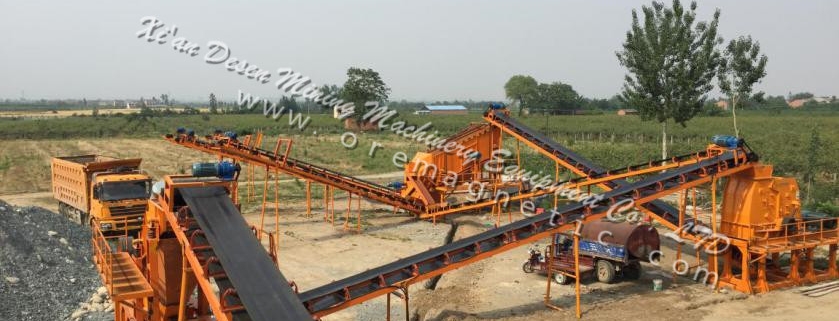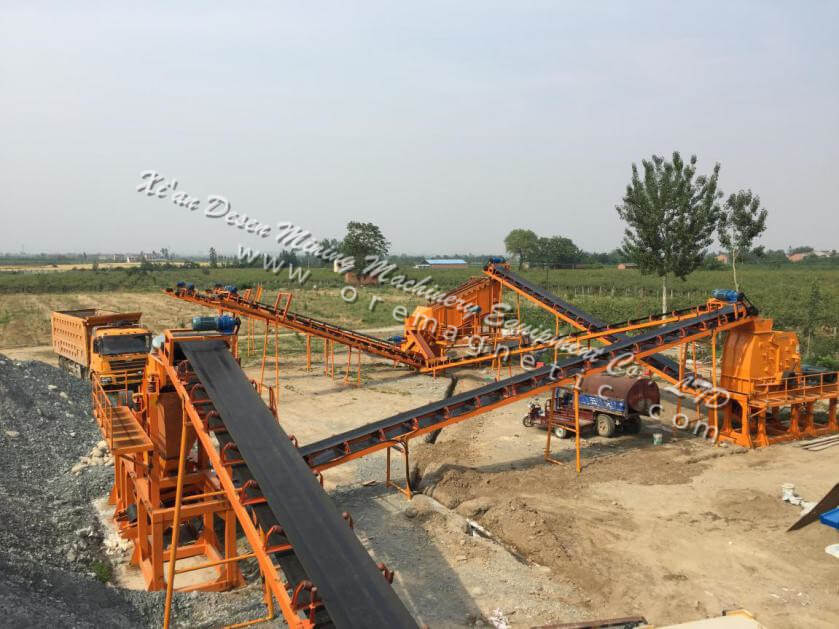Are you interested in installing the industrial conveyor yourself?
Among the production processes of sand and gravel aggregates, industrial conveyor are widely used and indispensable. Dasen mining has received many inquiries regarding the installation and disassembly of a belt conveyor or a part thereof. The following paper provides technical guidance by introducing the installation steps of a dtl140 / 140 / 4 * 710s industrial conveyor.
Note: dtl140 / 140 / 4 * 710s conveyor is equipped with 3 driving rollers and 4 710KW motors, which are driven by head single point drive. The hydraulic braking device is set at the head and the hydraulic tensioning device is set at the tail. The length of the machine body is 3200m, the strength of the conveying belt is St / S3150N / m, the width is 1400mm, the speed of the conveying is 3.5m/s, and the conveying capacity is 1400t / h.
1. Measurement and setting out
Determine the longitudinal centerline of the conveyor with a theodolite, and the deviation from the actual axis of the foundation shall not exceed 20mm. Lead out the drum axis and the bus projection line at the same time to measure the verticality between the drum and the longitudinal centerline during installation. The setting out of drum and frame shall be perpendicular to the longitudinal centerline, which can be checked by the Pythagorean theorem.
2. Installation of belt rack
It is necessary to assemble the head frame first, followed by the tail frame, and then the middle frame.
As a condition for the normal operation of the industrial conveyor, the center of the conveyor belt should be determined before installing the frame. All operation centers of the conveyor shall be in a straight line. During the installation of each frame, the longitudinal center position of the transportation distance shall be the same, and the longitudinal horizontal inclination angle must be within the allowable range.
A maximum error of *0.1mm shall be allowed between the single bent and the centerline, and a maximum error of 35mm shall be allowed between the conveyor belt and the centerline. Whenever all stand-alone frames are positioned correctly, all parts can be connected. After the connection is completed, the firmness of the industrial conveyor installation and the accuracy of the central position shall be checked.
3. Conveyor belt rollers installation
Start assembling the tensioning drum, steering drum, and transmission drum after installing the belt rack. Before drum assembly, the bearing shall be filled with lithium grease. The specific installation requirements are as follows:
1) The levelness of the drum shaft shall be less than 0.3/1000;
2) The relative deviation of the parallelism of the transmission drum axis is less than or equal to 0.4mm for multiple drive drums.
4. Installation of driving device
Make sure that the drive shaft of the belt conveyor is perpendicular to the center line, the centerline of the conveyor corresponds to the drive drum width, and the traditional shaft is parallel to the reducer shaft when installing the drive.
To ensure proper operation without load and power, all shafts and rollers must be leveled in advance. The horizontal error of the shaft shall be kept between 0.5-1.5mm. Moreover, during the installation of the driving device, the corresponding tensioning device shall be installed at the same time, and the centerline of the conveyor and the drum shaft of the tensioning device shall also be vertical.
5. Idler installation
An industrial conveyor installation would not be complete without idler installation. It has an important impact on the working efficiency and service life of the conveyor.
Following the installation of the rack, transmission device, and tension device, the roller bracket and upper and lower rollers should be installed. The belt conveyor machine shall be gradually arc-shaped. The distance between the brackets in the bending section shall be half of that of the ordinary bracket, and it shall be ensured that it has sufficient flexibility and reliability. After installation, all idlers shall be kept horizontal and parallel and arranged in rows. The horizontal centerline of the idler shall coincide with the longitudinal centerline of the conveyor, and the deviation shall not be greater than 3mm.
6. Conveyor belt installation and vulcanization
The vulcanization of adhesive tape joints directly determines the installation quality of adhesive tapes, which is the key to ensuring the strength and life of the joints. The adhesive tape used in this project is ST / S1600 type with 1400mm bandwidth. According to the requirements of tape parameters, lap length is 1950mm. The curing temperature is 150 ± 2 °C, the curing pressure is 1.8-2.0 MPa, the cure time T = 14 + 1.2 h, h is the thickness of the conveyor belt.
Tape after vulcanization reaction, so that the raw rubber into vulcanized rubber, joint strength should reach the strength of more than 90% of the tape, straightness tolerance less than 25mm. The joints shall be cured in one step. The sulfidation of the joints in this project adopts the oblique opening form.
7. Tensioner installation and accuracy requirements
1) The installation of the tensioning device should work reliably, the adjustment stroke should not be less than 1 / 2 of the whole stroke after the trial operation, and the tension device should be adjusted flexibly;
2) The deviation of the center line of the tensioning wire rope and the pulley rope groove and the vertical axis of the drum should be less than 10%.
8 System commissioning
Before the newly installed belt conveyor is officially put into use, it should be not less than 4 hours of no-load debugging and 8 hours of heavy load debugging trial operation.
① No-load commissioning
In order to ensure the work of the industrial conveyor is not biased, it is necessary to run the idling test machine in advance. The running rule of the drum, the contact degree of the conveyor belt surface and the guide plate, the working temperature of the transmission part should also meet the use requirements, and the necessary debugging work should be carried out. The machine can’t run until all the corrections are confirmed.
② Heavy load debugging
When carrying out the trial operation with load, the loading load of the conveyor shall be loaded by 20% first, and then the rated load of 50%, 80%, and 100% shall be gradually increased for trial operation. The total time of system load debugging should be more than 8 hours. Heavy load commissioning must meet the needs of flexible rotation of the components, stable operation, the operation of the brake device sensitive and reliability; The tensioning and cleaning devices are normal, the braking and anti-reverse devices are effective when stopping, the safety shields are complete and reliable, and the bearing temperature and temperature rise meet the requirements of specifications.
We can provide you with more information about the belt conveyor price. If you have any questions, please contact: Whatsapp:+8613319277356, Email:[email protected]


